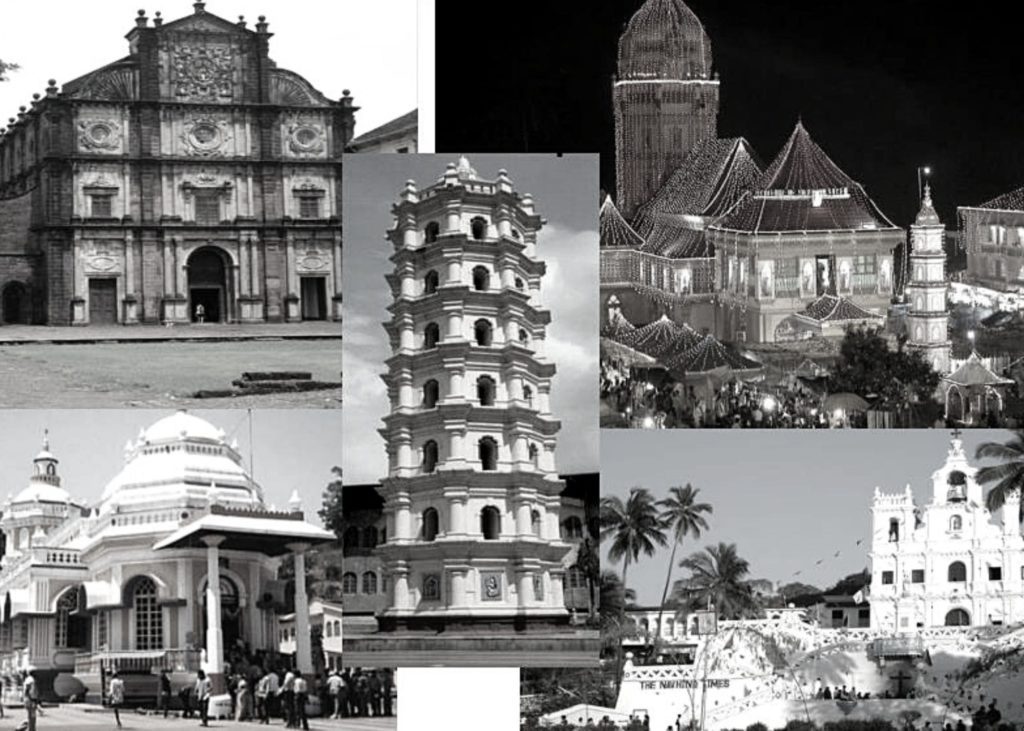Reading Time: 6 minutes
Soumya discovers a different Goa, staying with a Goan colleague. An exclusive for Different Truths.


Goa is a state I visit often, as it is part of the territory I oversee for my organisation, and is a popular venue to hold conferences, and I personally love the scenery and ambience in this beautiful, laid back, touristy, beach-bound state.
I usually stay in a hotel near the airport and as close to the beach as possible. But last time, I decided to see Goa a little more intimately, and accepted the invitation of a Goan colleague to go and stay in his village home and explore the countryside, avoiding the tourist beaches.
I decided to see Goa a little more intimately, and accepted the invitation of a Goan colleague to go and stay in his village home…
Accordingly, once the official business of launching a new scheme with the unavoidable meetings with the ministry, politicians, media, ad agencies, vendors et all was done and dusted, I checked out of the hotel, took an extended leave and moved to a different Goa.
The first thing you notice is the greenery. It’s a vivid green backdrop dotted with cottages, some painted colourfully. It is also teeming with shrines, Hindu or Catholic, depending on the population concentration, but often mixed. The standard uniform dress code for men seemed to be checked shorts and bare chests ala Sallu Bhai, which went with the weather, and loose shifts like nightdresses for the women. The ubiquitous vahana was the two-wheeler; scooties and bikes, perfect for the narrow winding roads, which were often blocked by someone pruning their coconut tree or repairing something.
The populace, in general, appeared to be at leisure, lounging around in the universal uniform of shorts in some veranda like sheds…
The populace in general appeared to be at leisure, lounging around in the universal uniform of shorts in some veranda like sheds, which were everywhere. On enquiry, I discovered that they were temple verandas, an essential part of Konkan temple architecture, which also doubles as the meeting place, village hall, whatever, and is the center of social and political life. There were groups of youngsters on bikes gathered around village squares, but these temple yards were by far the most popular place to congregate.
I think that the density of shrines per square mile or per capita must be the highest in Goa. Every family has a family deity. Every village has a village deity. Every mohalla (locality) has its own deity. In Catholic areas, the idols of the local gods have been replaced by icons of Mary or various Saints or sometimes just a cross, but their practices remain largely unchanged. They still go on processions round the village as the deities of the earlier religion did before them, and like their predecessors, congregated on feast days. Just the days have changed; instead of on Dussehra or Purnamasi, it’s on various feast days.
Richer and usually Brahmin homes are built around a courtyard, with a Tulsi manch in its center.
Richer and usually Brahmin homes are built around a courtyard, with a Tulsi manch in its center. In equivalent Catholic homes, it has been replaced by a cross. Usually, the village is divided into mohallas, each representing a separate caste based on profession. The house I was in belonged to the leather workers area and their neighbours were the washermen. These were poorer areas, and the houses did not have interior courtyards, but a central all-purpose hall, for gathering, dining, entertaining and pooja, as a deity graced a niche here too. Bedrooms led off this central hall. My host, who had prospered financially, had built large cement double storied house but had kept the original plan intact, as I could see from the neighbouring cottages. The house was painted in bright colours and was shared by the extended family.
There was also the family temple next to the house, which served the whole clan and the mohalla of leather workers. The veranda was as usual doubling as a council room cum recreation area cum village hall. I had a chance to examine the temple carefully. Inside the garbhagriha, or sanctum sanctorum, were three deities, the chief with horse and sword, called Vishweshswara, or Lord of the world. He is the Kuldawat, or god of the clan. He had a companion and a second in command, and he sits on the earthen floor, not on the podium. He is called Nitkari, or the god of daily routine matters. Outside the temple, there is another god, who does not have a temple, but sits under a tree. He is called Rastroli. He is in charge of villagers, who have moved out and all mundane prayers. Problems he cannot handle are referred to Nitkari, and he in turn only refers the most difficult cases to Kuldawat.
The first crop, or the first time anything new is being acquired, is offered to the temple before taking it home.
All matters of family, births deaths marriages, acquiring a new property, starting a new venture, planting of crops, harvesting all must be necessarily referred to these deities and their permission and blessings sought. The first crop, or the first time anything new is being acquired, it is offered to the temple before taking it home. This applies to clan members anywhere in the world, so wedding invitation cards, postcards, photos of new cars, etc. were stacked there. Everyone tries to visit the shrine at least once a year, whether they are in Mumbai, Kolkata, Lisbon, London, or Rio; cities with the highest expat Goan populations, in that order.
I understood that the Catholics did the same, except that it was the family, clan, or village patron Saint who ruled their lives.
There were also two beautiful examples of amity between sects that I came across.
The first was the temple of Jagreshwara, an incarnation of Lord Shiva. He does not have an icon but is worshipped in the form of a flame. Originally, he was in the open, but his popularity was resulting in a temple being constructed. His feast day is the first Monday after Christmas, and his chief devotees and patrons are Catholic. Both communities worshipped him, as his efficacy in granting prayers was renowned, but the Catholics took the lead, and he was their clan, God. His feast was celebrated by a morality play with a dose of humour, called Dando, where female roles are played by men. Mainly farmers seeking a bountiful harvest take part, and the procession is led by Catholics.


In the morning, the Hindus led the Choir in the Church and led the prayers too, and in the afternoon the Catholic priest participated in the Pooja…
The other was the Satyanarain pooja in the village. In the morning, the Hindus led the Choir in the Church, and led the prayers too, and in the afternoon the Catholic priest participated in the Pooja and he and his congregation stayed for the Prashad and the lunch.
Breakfast in a Goan village is freshly baked hot Pao, or buns, hard exterior and soft inside like French bread, with spicy lentils and veggies and hot sweet tea. The Pao is delivered by the village baker to all homes, as baking at home is now a thing of the past.
Lunch is rice and shellfish curry, and some small fish called Lepo, as well as dried shrimp sauce. In my honour a bigger fish called Morso and an even bigger one called Chonak was cooked, but these are festive fare.
Panas, or Jackfruit is popular, and an idli-like dish called panas bhakri or jackfruit cake was served, a traditional dish fast disappearing. We also had some sour-sweet dark blue berries called kanna, which are available wild.
The popular evening adda was at the Gadi, or village pub serving the country liquor Feni, made from both Cashew and Coconut…
The popular evening adda was at the Gadi, or village pub serving the country liquor Feni, made from both Cashew and Coconut, a clear strong liquid with a pungent smell which burns the throat. There are lemongrass, roots, ginger, and other flavours available, tempered with local herbs. In season you also get Urak, the fiery semi distilled version obtained in the first crop. You get it in small glasses and toss it in like Tequila.
Most villagers have moved to the city for work, and agriculture is largely an indulgence for home consumption. The coconut plantations are a valuable source of income. Another popular side income is letting off their homes to backpackers, at what to the local is a fabulous rent, and to the tourist thinking in Dollars or Euro, dirt cheap. So, the village scene is interspersed with scantily clad white skin and blond mops.
Locals rarely visit the beaches, except for religious festivals that require it, or unless they are involved in the tourist trade.
The area is also dotted with various crumbling forts no one seems to have heard about…
The area is also dotted with various crumbling forts no one seems to have heard about, and quite a few ancient temples, including a thousand-year-old stone structure lost in a forest. There are also many hidden waterfalls, a Sweetwater lake within hundred yards of the sea, and some secret coves and tiny beaches in scattered uninhabited islands approachable only by boat, which very few tourists are aware of.
On my brief vacation in the other non-touristy Goa over, I returned to the grind in the maximum city, with a new outlook of my favourite holiday destination.
Visuals by Different Truths


















Undoubtedly, the best way of making the best of one’s trip is to stay with the local to enjoy the Real feel of a tourist place 👍👍
Absolutely mam